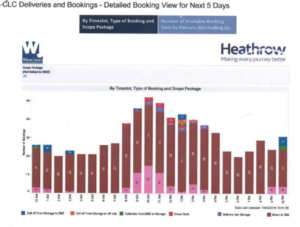The use of Delivery Management Systems (DMS) in London has grown in recent years, and are now viewed as essential tools to address an increasingly complex and regulated construction environment. The emergence of DMS, therefore, is closely linked with this evolving compliance landscape.
With an additional more than towers (20 storeys or more) approved for construction in London, the construction industry is already a significant contributor towards road congestion in London. By looking at journeys made by large trucks to and from construction sites, Transport for London (TfL) aims to implement systems that will help alleviate the pressure on the road network.
The aim of new research is to provide TfL with recommendations for the construction sector and local authority planners, for effective use of DMS, truck holding areas and construction logistics plans (CLP).
Delivery Management Systems
DMS are increasingly viewed as essential in terms of effectively managing HGV deliveries, particularly in areas of inner London experiencing intense levels of construction activity. Recent years have witnessed an increase in use of (DMS) in London, where increasingly complex site environments and growing regulation are prompting adoption of software solutions.
Truck Holding Areas
Where truck holding areas are present, construction sites benefit from greater control over delivery logistics. However, generally there is a shortage. The approval system is complicated and needs simplifying and construction sites need to put more thought into the provision of holding areas at an earlier stage of the planning process.
Construction Logistics Plans
Construction companies have been completing the CLP as per the stated requirements and the majority of sites had them to hand when visited. However, they are not being used as a monitoring tool. The time gap between the initial planning application and commencement of the construction work means important aspects, such as truck holding areas, are deprioritised. Local Authorities do not have the resource to advise and monitor sites on effective CLP management. CLPs should be more than just a tick-box exercise and could benefit from greater monitoring and enforcement.
Lessons learned
The construction sector can learn a great deal from the application of logistics in other sectors, in particular by moving towards a just-in-time approach (where materials are pulled, rather than pushed) through the supply chain.
The use of DMS in construction logistics has increased in recent years and is now viewed as an essential tool in effectively managing the flow of HGV deliveries in London. As a result, there are now a range of robust products on the market, the majority of which are provided by logistics companies. As usage of DMS increases, and a more integrated approach is taken towards the entire supply chain, the need for interoperable systems will grow. This could enable DMS to connect with other construction related management systems (such as BIM) leading to greater efficiencies.
While CLPs are referencing both DMS and truck holding areas, overall they require greater commitment from both the construction sector and local authorities. By doing this they can help create a more robust, effective and accountable document.
Read the full report here.


